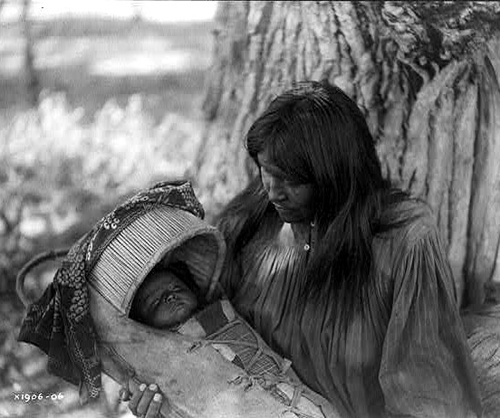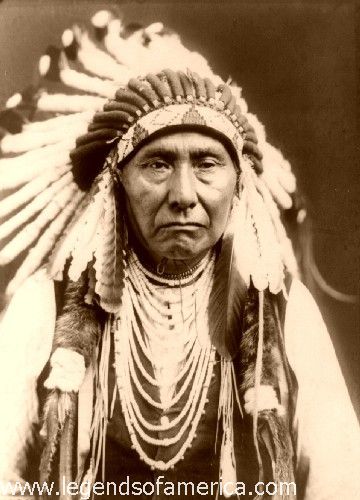Chief Joseph of the Nez Perce Indians once said the following at Lincoln Hall in Washington D.C. when he spoke about Indian Affairs in 1879: “We only ask to live as other men live. We ask to be recognized as men.” Throughout history, the Native American people have been persecuted, thrown from their land, hunted down as criminals, forced to live in reservations, and then told what they can and cannot do. The United States government has continually changed their position on how to treat these people. Do we assimilate them into our society regardless of what they want because they were born on U.S. soil, or do we recognize them as free nations within our borders? Forcing them to assimilate would be denying them their constitutional right to live how and where they want or do what they want. On the contrary, recognizing them as a free nation would, theoretically, deny the government the privilege of dictating what a free nation may do. We as Americans have customarily believed in promoting democracy yet we have withheld democracy from these people. We have designated ourselves the dictators of a minority and turned a blind eye. Therefore the question we must as, as United States citizens, are to make an informed decision about how to treat these individuals and these nations are the following: How were the Native Americans oppressed in history? In what ways are they oppressed today? How have these oppressions throughout history affected their economic and social wellbeing?
Support:
1) In 1830, pressed by settlers to solve the unsettled “Indian problem,” President Andrew Jackson signed the Indian Removal Act of 1830, which authorized the President to grant unsettled lands west of the Mississippi River in exchange for Native American lands within existing borders.
- This act, aside from the fact that it allows for a great deal of legal loopholes, authorizes the American government to forcibly remove Native Americans from their homes without their consent.
- Andrew Jackson in his Second Annual Message to Congress on December 6, 1830, stated the following: “It gives me pleasure to announce to Congress that the benevolent policy of the Government, steadily pursued for nearly thirty years, in relation to the removal of the Indians beyond the white settlements is approaching to a happy consummation,” (Library of Congress, Primary Documents in American History: Indian Removal Act).
2) The impacts of this act are perhaps more widely known than the act itself. Russell Thornton, a professor at the University of Minnesota, researched the drastic decreases in the Cherokee population during the infamous “Trail of Tears.”
- He describes the forced relocation of the Native American tribes with a gleam of sorrow stating that, “few events in the history of any people were as tragic as these journeys were for the Indian tribes involved. In fact, the removal of the Cherokee during the late 1830s was so arduous that they subsequently named it Nunna daul Tsuny.”
- The Cherokee Indians, after resisting the U.S. government’s pressures to move west, were finally defeated when three of their people, without consent of the majority and without the authority to do so, signed the Treaty of New Echota which exchanged eastern lands for lands west of the Mississippi River in Indian territory and for the payment of $15,000,000 to the Cherokees.
- In 1838 the Cherokees were disarmed and General Winfield Scott was sent to oversee their removal. In October of 1838, the Cherokees began their own removal at the end of a bayonet. Traveling in thirteen recorded groups, averaging about 1,000 people each, they travelled primarily overland north and west across Tennessee and Kentucky.
- As a result of the rounding up, the actual removal, and the first year in Indian Territory, thousands of Cherokee are said to have died throughout the entire Trail of Tears ordeal.
3) Some might say, “Well that was in the past during the time when slavery was still a prevalent custom. We, today, should not be held accountable for the mistakes of our past.” This is a very true statement except for the fact that the discrimination of the Native Americans did not end with the Emancipation Proclamation or with the signing of the 14th amendment.
- Today, the federal government declares it the policy of the government to treat the Native Americans as a sovereign nation, yet if that is the case, why did the state of California attempt to implement a 33 percent business tax on Indian casinos on Indian land?
- Proposition 68 on the November 2004 California General Election called for a revision to the Indian charters, which allowed casino gaming on tribal lands, adding as a provision that 30 percent of their net wins from their slot machines be paid to the Gaming Revenue Trust Fund (GRFT, a state fund established by this measure), 2 percent of their net win be paid as a city tax, and 1 percent to be paid to the county within which the casino resides (California Secretary of State, Analysis by the Legislative Analyst: Proposition 68).
- This analysis specifically states that as a sovereign nation, the Native American tribes are largely exempt from federal, state and local taxes.
- California has no business going to Mexico and saying, “Hey, your country butts up against my state. I demand 30 percent business tax,” nor does Michigan have the right to demand the final say on activities done within Canadian borders, yet Indian tribes are required to get U.S. federal and state permits to build on their own land and are then charged taxes on any proceeds they receive.
4) In another example of continued Native American persecution, there is a continued debate about the legality of archeological excavations on Native American burial grounds. James Riding In, a Pawnee Indian is actively opposed to the “scientific grave looting” done by archaeologists.
- A number of Native American religions believe that in order for your soul to make it to the afterlife, you must maintain a lasting burial. Riding In views “archaeology as an oppressive and sacrilegious profession that claimed ownership over many of our deceased relatives, suppressed our religious freedom, and denied our ancestors a lasting burial.”
- When a crematorium was found to be selling the bodies of American people to institutions for scientific purposes, the federal government launched a full scale investigation and convicted multiple offenders. However, an archaeologist can do the exact same thing, desecrating Native American burial grounds and cemeteries claiming advancement for science, and he is considered a preserver of the ancient cultures regardless of the fact that the culture still lives on today in the descendents infuriated by the blatant desecration of their ancestor’s tombs.
- What is the difference between digging up, selling to a museum, and displaying the remains of the Native Americans without the direct permission of next of kin and the selling of American’s bodies for scientific study without the permission of the next of kin?
5) After identifying the continuance of prejudice, the question then becomes how are the Native Americans today economically and how has these prejudices impacted their ability to make money?
- As William H. Kelly describes in “The Economic Basis of Indian Life,” there are those Native Americans who are seeking to solve their economic problems by leaving the reservation for wage work in industry and business, but “the economic basis of Indian life is income from wage work, largely periodic and seasonal, which is used to support an uneconomic system of land ownership and land utilization. This is true even for the Navaho, presently enjoying the largest tribal income in the country, because oil income is not being paid per capita to the 80,000 tribesmen, but is being used for educational and resources development purposes…Interest and concern for the Indians stem from the fact that they are not moving into the American economic system in the same way or on equal terms with other citizens, despite the fact that they represent the one minority group in this country whose economic and social well-being has been the special responsibility of, and partly subsidized by, the federal government,” (William H. Kelly, The Economic Basis of Indian Life pg. 71-72).
- Dr. David L. Vinje describes in his article entitled “Native American Economic Development on Selected Reservations: A Comparative Analysis,” the economic distress of some tribes when he states that “By 1990, the Reagan/Bush era, combined with the collapse of the natural resource markets, left many of the reservations under discussion here worse off than they were at the end of the 1970s. Overall the twenty-three reservations covered, the median number of families below the poverty level had increased to 48.8 percent by 1990 compared to a figure of 44.1 percent as of 1980.”
- He continues by describing the economic necessities of gambling for the Native Americans stating that “it is clear that Indian gambling is the fastest growing source of economic activity on the reservations. It is providing a much needed source of reservation jobs, and it is generating tribal revenues that have gone to support reservation projects encompassing improved housing, educational scholarship, medical clinics, repurchase of reservation land held by non-Indians and the establishment of industrial parks for new business opportunities,” (Dr. David L. Vinje, Native American Economic Development on Selected Reservations: A Comparative Analysis, pg. 427-442).
- 48.8 percent of the Native American families in 1990 lived under the poverty line practically dictating that Native Americans required gambling to meet the economic needs. The fact that Native Americans are socially confined to their reservations by threats of racial discrimination, stereotypically decreased educational opportunities, and continued suppression by the strongest government in the world all lead to the economic depravation of the Native American people confined to reservations.
6) The economic impacts of continued racial discrimination also contribute to the psychological and physical health of the Native American tribes living on federally assigned reservations.David D. Barney acknowledges that there is a trend of depression and poor health among Native Americans and Alaskan Natives as a result of poverty and racial discrimination.
- He states in his article “Risk and Protective Factors for Depression and Health Outcomes in American Indian and Alaska Native Adolescents” that “the health status of American Indian and Alaska Native adolescents has also been identified as poorer than that of adolescents of other racial or ethnic groups (Office of Technology Assessment 1990, 1986; Indian Health Services 1998). For American Indian and Alaska Native adolescents, social and health indicators illustrate increased risk of poor outcomes on almost all well-being measures. Overall, in American Indian and Alaska Native adolescents (ages 15 to 24), the mortality ratio is approximately three times greater (2.7:1) than for U.S. all races (Office of Technology Assessment 1986). American Indian and Alaska Native adolescents are exposed to poverty and racial discrimination, which severely limit individual, family, and community prosperity.”
- This study suggests a strong correlation between poverty and racial discrimination and Native American adolescents suffering from severe depression leading to an increased trend towards suicide.
***Research is still being conducted and this outline will continue to be expanded as research is cumulated.


2 comments:
This outline represents a lot of work. I wonder if you are taking upon yourself too many areas. If you find you have more than enough info in one area, you might drop or diminish to mentioning only one or two of the tribes. That way you could get into more detail in one area and it will still serve as an example of what many experienced.
Remarkable blog post! Could you followup on this astounding subject?
Post a Comment